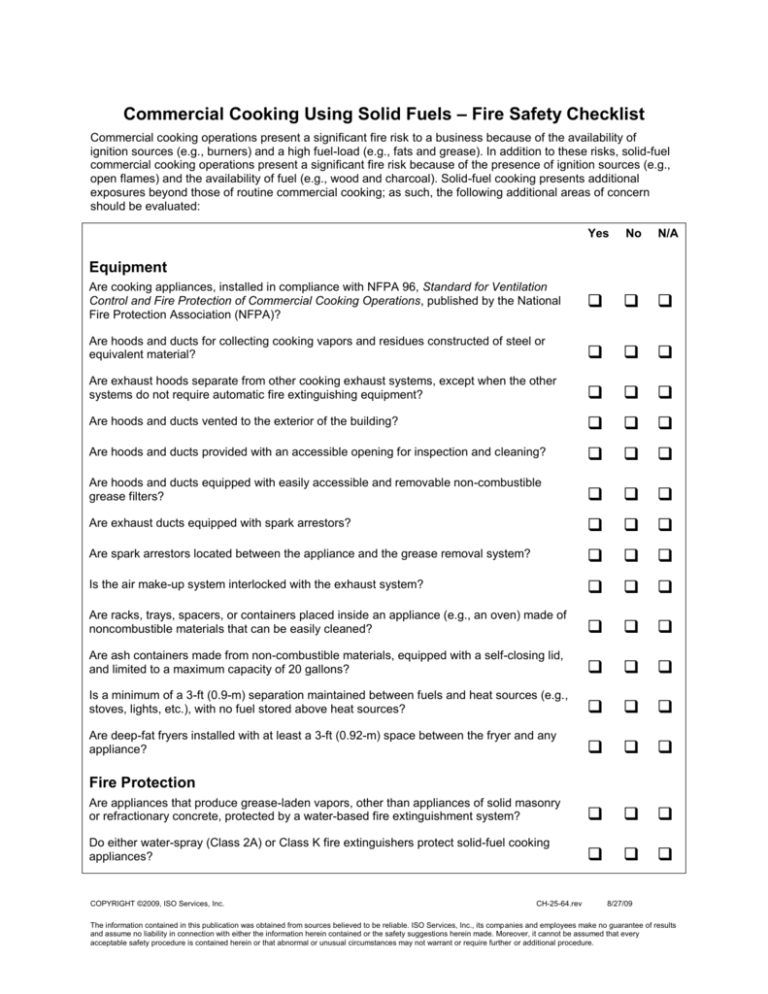Fire Safety Checklist
advertisement

Commercial Cooking Using Solid Fuels – Fire Safety Checklist Commercial cooking operations present a significant fire risk to a business because of the availability of ignition sources (e.g., burners) and a high fuel-load (e.g., fats and grease). In addition to these risks, solid-fuel commercial cooking operations present a significant fire risk because of the presence of ignition sources (e.g., open flames) and the availability of fuel (e.g., wood and charcoal). Solid-fuel cooking presents additional exposures beyond those of routine commercial cooking; as such, the following additional areas of concern should be evaluated: Yes No N/A Are cooking appliances, installed in compliance with NFPA 96, Standard for Ventilation Control and Fire Protection of Commercial Cooking Operations, published by the National Fire Protection Association (NFPA)? Are hoods and ducts for collecting cooking vapors and residues constructed of steel or equivalent material? Are exhaust hoods separate from other cooking exhaust systems, except when the other systems do not require automatic fire extinguishing equipment? Are hoods and ducts vented to the exterior of the building? Are hoods and ducts provided with an accessible opening for inspection and cleaning? Are hoods and ducts equipped with easily accessible and removable non-combustible grease filters? Are exhaust ducts equipped with spark arrestors? Are spark arrestors located between the appliance and the grease removal system? Is the air make-up system interlocked with the exhaust system? Are racks, trays, spacers, or containers placed inside an appliance (e.g., an oven) made of noncombustible materials that can be easily cleaned? Are ash containers made from non-combustible materials, equipped with a self-closing lid, and limited to a maximum capacity of 20 gallons? Is a minimum of a 3-ft (0.9-m) separation maintained between fuels and heat sources (e.g., stoves, lights, etc.), with no fuel stored above heat sources? Are deep-fat fryers installed with at least a 3-ft (0.92-m) space between the fryer and any appliance? Are appliances that produce grease-laden vapors, other than appliances of solid masonry or refractionary concrete, protected by a water-based fire extinguishment system? Do either water-spray (Class 2A) or Class K fire extinguishers protect solid-fuel cooking appliances? Equipment Fire Protection COPYRIGHT ©2009, ISO Services, Inc. CH-25-64.rev 8/27/09 The information contained in this publication was obtained from sources believed to be reliable. ISO Services, Inc., its companies and employees make no guarantee of results and assume no liability in connection with either the information herein contained or the safety suggestions herein made. Moreover, it cannot be assumed that every acceptable safety procedure is contained herein or that abnormal or unusual circumstances may not warrant or require further or additional procedure. Yes No N/A Are employees trained in the use of portable fire extinguishers and water hoses? Are fire extinguishing systems covered by a service and maintenance program? Is a water hose, having a delivery rate of at least 5 gpm (19 L/min) at 40 psi (275 kPa), provided for appliances that have a combustion chamber larger than 5 ft3 (0.14 m3)? Are hose nozzles limited to only those that cannot produce a straight water stream? Combustion of fuel-air mixtures? Explosion hazards? Sources of ignition? Functions of controls and devices? Are operating instructions for the appliances readily accessible? Are control valves for auxiliary fuels and systems, such as gas and electric service, readily accessible and in good working condition? Are solid-fueled, deep-fat frying appliances limited to not more than 1 qt (0.9 L) of grease or fat? Are ashes and spent fuels removed from the combustion chamber of appliances at least daily? Are ashes spread out inside the combustion chamber of the appliance, wet down with water prior to removal, and disposed of in a non-combustible container? Is fuel storage in the cooking area limited to a one-day supply? Is fuel storage separated from flammable liquids, foods, and chemical storage? Is the use of accelerants for starting and fueling prohibited? Are appliances and systems inspected at least monthly? Is the combustion chamber of the appliance cleaned (i.e., residue removed down to the chambers surface) and inspected weekly? Is the appliance’s chimney, including the spark arrestor, inspected weekly for residue, corrosion, and restrictions? Operations Are employees trained in the safe operation of cooking equipment, including: COPYRIGHT ©2009, ISO Services, Inc. EngineeringAndSafety@ISO.COM Page 2




